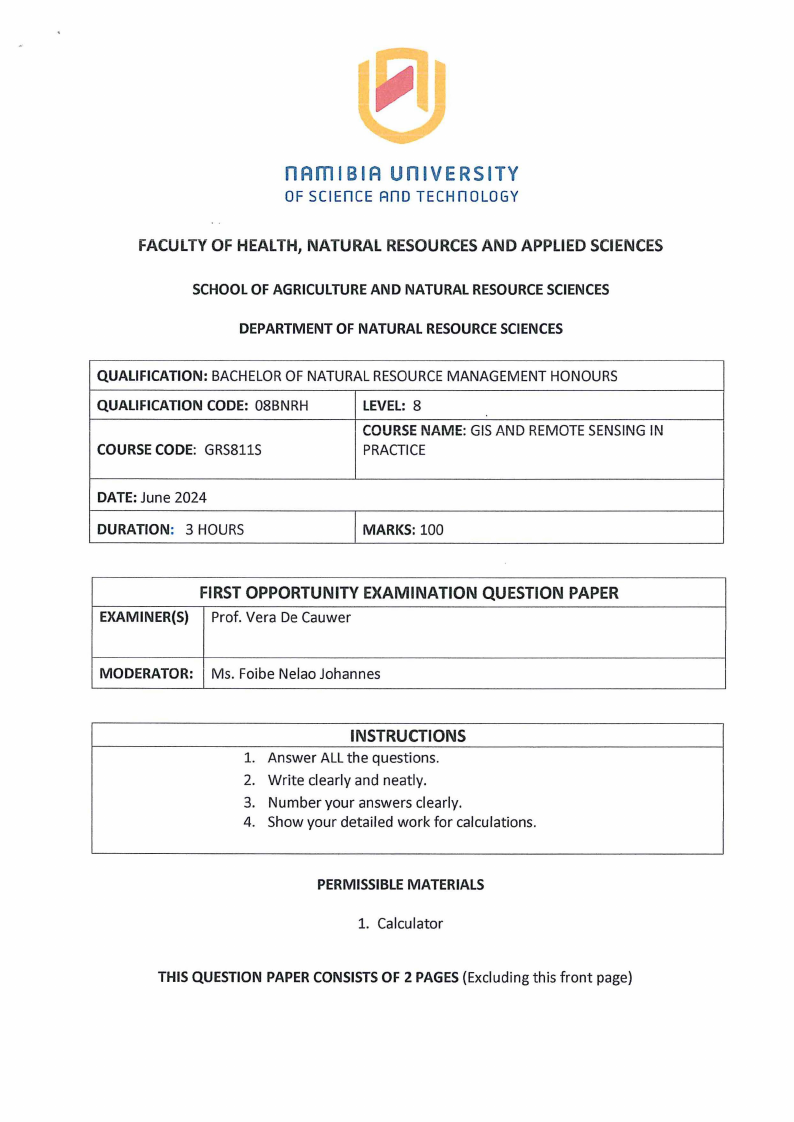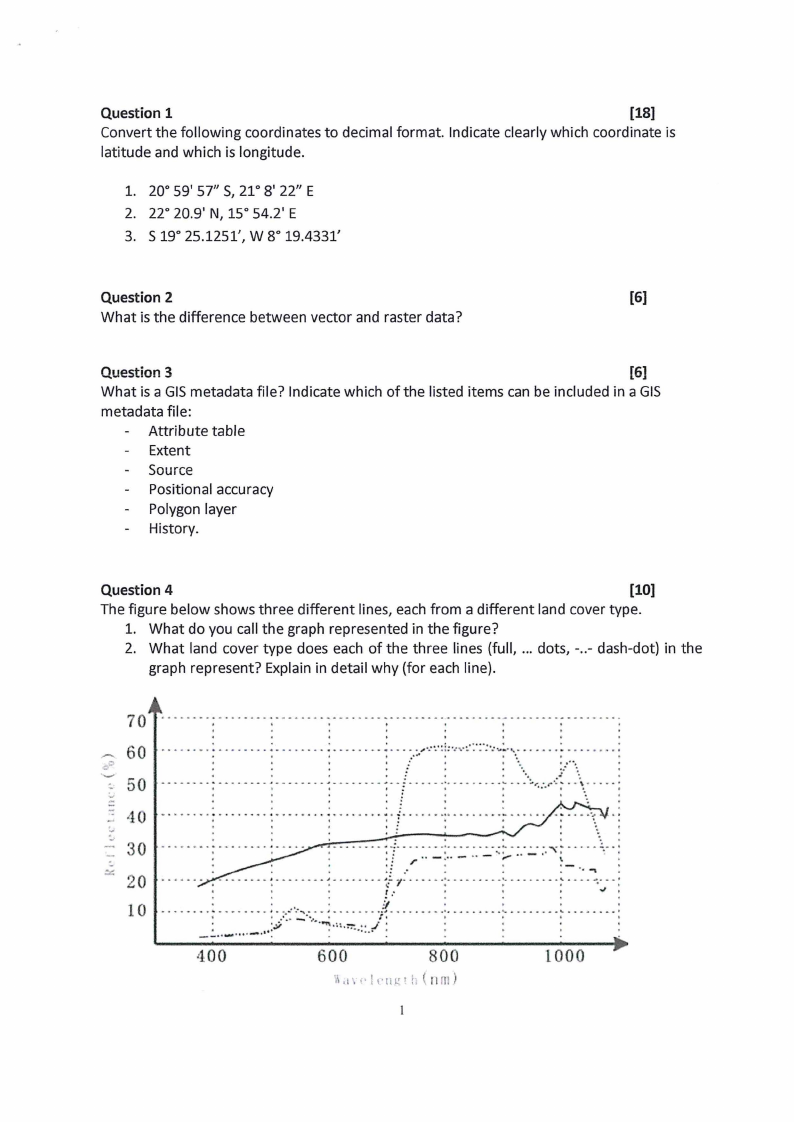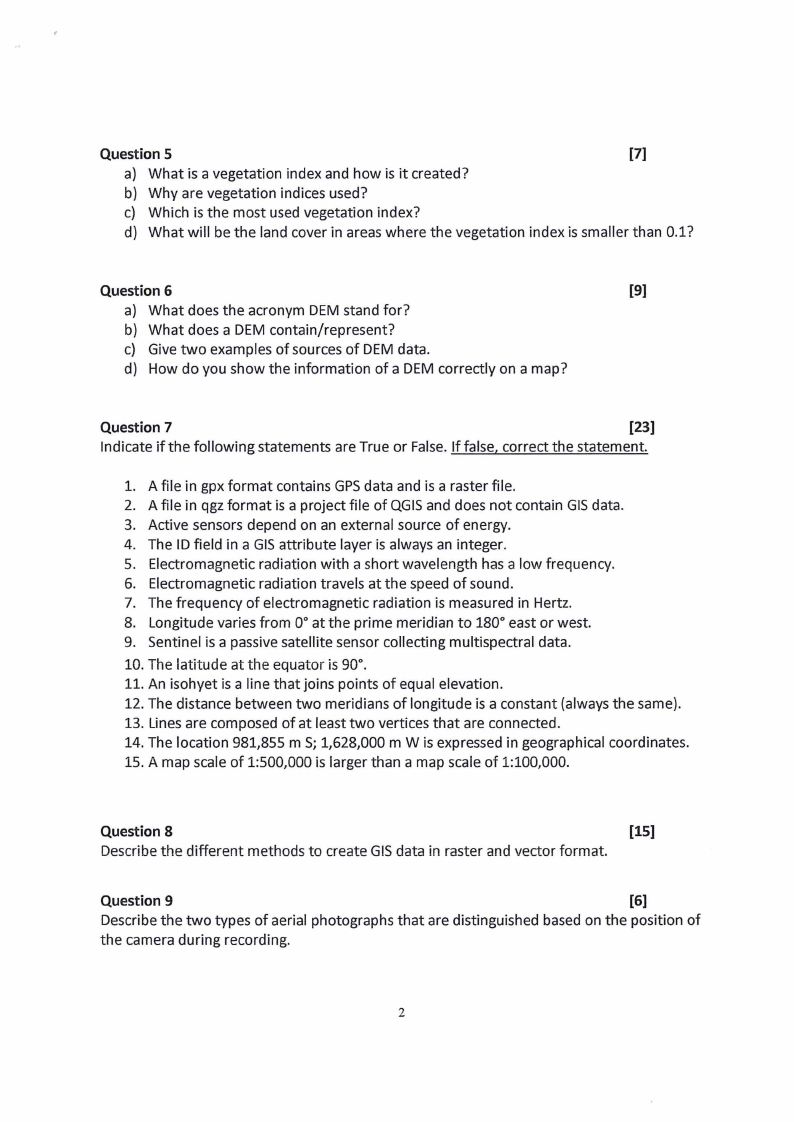 |
GRS811S-GIS AND REMOTE SENSING IN PRACTICE-1ST OPP- JUNE 2024 |
 |
1 Page 1 |
▲back to top |

nAm I BI A un IVE RSITY
OF SCIEn CE Ano TECHn OLOGY
FACULTYOF HEALTH,NATURAL RESOURCESAND APPLIEDSCIENCES
SCHOOLOF AGRICULTUREAND NATURALRESOURCESCIENCES
DEPARTMENTOF NATURALRESOURCESCIENCES
QUALIFICATION: BACHELOROF NATURAL RESOURCEMANAGEMENT HONOURS
QUALIFICATION CODE: 08BNRH
COURSECODE: GRS811S
LEVEL: 8
COURSENAME: GIS AND REMOTE SENSING IN
PRACTICE
DATE:June 2024
DURATION: 3 HOURS
MARKS: 100
FIRSTOPPORTUNITY EXAMINATION QUESTION PAPER
EXAMINER(S) Prof. Vera De Cauwer
MODERATOR: Ms. Foibe Nelao Johannes
INSTRUCTIONS
1. Answer ALL the questions.
2. Write clearly and neatly.
3. Number your answers clearly.
4. Show your detailed work for calculations.
PERMISSIBLEMATERIALS
1. Calculator
THIS QUESTION PAPERCONSISTSOF 2 PAGES(Excluding this front page)
 |
2 Page 2 |
▲back to top |

Question 1
[18]
Convert the following coordinates to decimal format. Indicate clearly which coordinate is
latitude and which is longitude.
1. 20° 59' 57'' S, 21° 8' 22" E
2. 22° 20.9' N, 15° 54.2' E
3. S 19° 25.1251', W 8° 19.4331'
Question 2
[6]
What is the difference between vector and raster data?
Question 3
[6]
What is a GISmetadata file? Indicate which of the listed items can be included in a GIS
metadata file:
- Attribute table
Extent
- Source
Positional accuracy
Polygon layer
History.
Question 4
[10]
The figure below shows three different lines, each from a different land cover type.
1. What do you call the graph represented in the figure?
2. What land cover type does each of the three lines (full, ... dots, -..- dash-dot) in the
graph represent? Explain in detail why (for each line).
70 . . . . . ........- - -- . - . - . - - . - . -- - - . - . -- - - - . - - - - ...- - - - - - - - . - - - - - - . - -..- - . - - - - . - ...- - - - ... - ..
I
I
t
I
t
t
I
•
·-~-· 60
Co 50
;_,
.-:. 40
:.,
-.. 30
:::,:
20
-- 0
I
I
I
t
-· ..- -- : ...... ... -- . - - ;_ -- . .. ;_ ---- - . - ... ·- .,-:·.•:;:-..-.-.-.·:·:·.:.:.·..:.-,... -- .. : .......... :
•
•
•
f
.....
•
'
••
'
•
: : ( /- ·:· / \\ ........
........
· .......
•
........
I
.:
· ....
t
••
• ••••
........ . .':·.·..:-..,. .. ..... \\
. .. . . .. ...... - .. - ....... " ............ •·.... .,.." - .......... !........
...u, ......
.
,. .. ...
•
t;
...-.-...--.:..-.....-.:....- ~.-:--.-:-.±--"---.~-:··t---:..:..-·~--:-:-:..-:.._.·:~-:..;_;·.' [. -..- .~. .-:
.
.: r .
•
•
.
.
······· : ········~········~········r
.: 1·: ·····.·!·········(····. ·····.•··-·ir~-~··;
10 ....~..• L:.~O .•'•~-.•~•:_,::..~!;.Ii~.·..·:.:.-•;..~..·.·:.;.·I_..~./.:.·.·I.r........fi.
400
600
800
'i\\ ,I \\ ! ' • I • ll I! I l, { II Ill )
1000
 |
3 Page 3 |
▲back to top |

Question 5
[7]
a) What is a vegetation index and how is it created?
b) Why are vegetation indices used?
c) Which is the most used vegetation index?
d) What will be the land cover in areas where the vegetation index is smaller than 0.1?
Question 6
[9]
a) What does the acronym DEM stand for?
b) What does a DEM contain/represent?
c) Give two examples of sources of DEM data.
d) How do you show the information of a DEM correctly on a map?
Question 7
[23]
Indicate if the following statements are True or False. If false, correct the statement.
1. A file in gpx format contains GPSdata and is a raster file.
2. A file in qgz format is a project file of QGISand does not contain GISdata.
3. Active sensors depend on an external source of energy.
4. The ID field in a GISattribute layer is always an integer.
5. Electromagnetic radiation with a short wavelength has a low frequency.
6. Electromagnetic radiation travels at the speed of sound.
7. The frequency of electromagnetic radiation is measured in Hertz.
8. Longitude varies from 0° at the prime meridian to 180° east or west.
9. Sentinel is a passive satellite sensor collecting multispectral data.
10. The latitude at the equator is 90°.
11. An isohyet is a line that joins points of equal elevation.
12. The distance between two meridians of longitude is a constant (always the same).
13. Lines are composed of at least two vertices that are connected.
14. The location 981,855 m S; 1,628,000 m Wis expressed in geographical coordinates.
15. A map scale of 1:500,000 is larger than a map scale of 1:100,000.
Question 8
[15]
Describe the different methods to create GISdata in raster and vector format.
Question 9
[6]
Describe the two types of aerial photographs that are distinguished based on the position of
the camera during recording.
2





